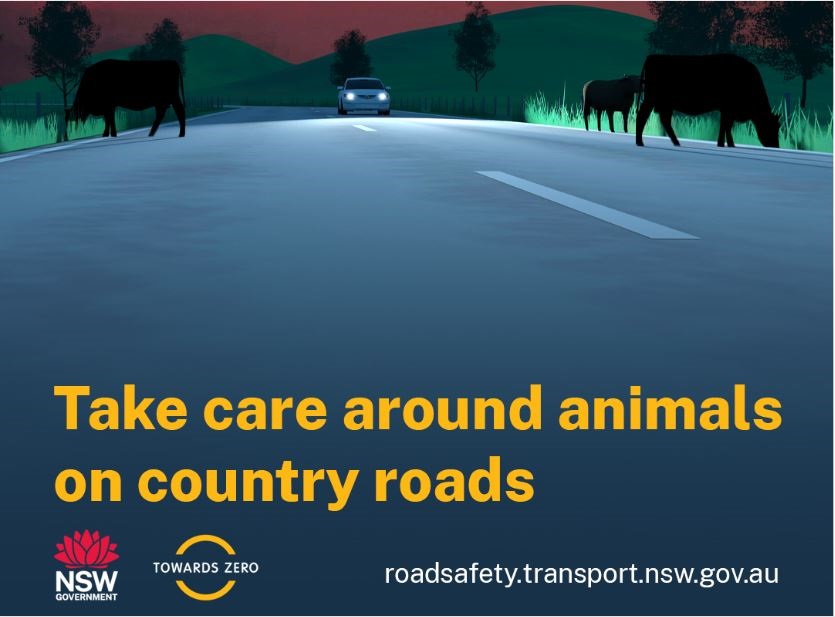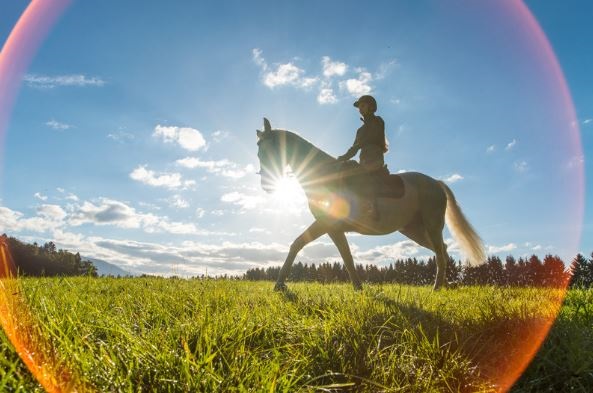Animal collisions can pose a big risk when driving or riding on country roads, especially at dusk and dawn. Wildlife, such as kangaroos, as well as livestock, can be fast and unpredictable. When they stray onto the road, it’s hard to know what they’ll do next. By slowing down and staying alert, you can help keep everyone safe.
1) Reduce Speed: Slow down and look out for wildlife on or near the roadside.
2) Stay Alert: Animals can be more active near waterholes and creeks and harder to see at sunrise and sunset. They can be fast and unpredictable. Stay alert and expect the unexpected.
3) Brake Safely: Apply your brakes in a careful, controlled manner. Leave space and pass with care when it is safe to do so.
4) Never Swerve: Take great care if you manoeuvre to avoid an animal. You may lose control of your vehicle if you swerve to harshly.
5) Follow Animal Warning Signs: Take note of warning signs alerting you to the presence of animals in the area. If you see these signs, slow down, stay alert and be prepared to stop if required.

Between 2013 and 2022* there were 1,384 casualty crashes with an animal on a country road which resulted in injury or death to the road user (*preliminary data as at 22 May 2023)
One in every 41 crashes resulting in injury or death on country roads involve a vehicle hitting an animal.
Impacts with kangaroos make up the highest number of serious casualties involving a crash with an animal on a country road.

If you hit a domestic animal, contact the owner, Police or RSPCA.
Injured domestic animals should be taken to the nearest vet or animal shelter.
Should you injure or kill a native or wild animal, try to remove it from the road but take care as some animals carry young in their pouches.
Hurt animals can be cared for by the Wildlife and Information Rescue Service (WIRES).
Wildlife Rescue Line: 13 000 WIRES or 1300 094 737
The Bellingen Shire Council has a large network of rural roads where wildlife activity is high, especially from dusk to dawn. Council is often approached with requests to install roadside wildlife warning signs. It is assumed that these signs will alter driver behaviour by indicating the presence of wildlife on the road and, thereby, reduce wildlife fatalities. However, research indicates that traditional wildlife signage does not effectively reduce roadkill numbers and it is not feasible to install warning signs on every road where wildlife is sighted. Signage is installed sparingly and at locations clearly identified as wildlife black spots. If the preservation of wildlife is considered critical at a location, other management treatments will also need to be considered.
WILDLIFE BLACK SPOT REPORTING:
To support a wildlife black spot request, please complete the form below and provide as much of the following information as possible.
Wildlife Black Spot Reporting Form
Note, Council is only responsible for the management of local roads within the local government area. State roads (generally the main highways) are managed by Transport for NSW and enquiries regarding these roads should be addressed to TfNSW.
When travelling on rural roads it is not uncommon to find livestock crossing as many farmers may own property on either side of the road. Slow down when you see animal warning signs. Animals are more active near waterholes and creeks, and are harder to see at sunrise and sunset.

In and around the Bellingen Local Government Area you may come across horses on or beside the road. Horses can be unpredictable and easily scared so it's important to take extra care when driving near them.
In NSW, horse riders have the right to share our roads. They have the same rights and responsibilities as other drivers, motorcycle riders and bike riders.
Key messages for motorists
- Be aware that horses can be easily frightened and unpredictable.
- Slow down and take extra care on bends, crests and on narrow roads, particularly in areas close to horse riding schools or where you see warning signage.
- If you’re passing a horse, whether it’s being ridden or led, or is pulling a vehicle, remember to:
- Slow down and allow plenty of room when overtaking
- Never use your horn or rev your engine, as this could scare the horse.
- It’s not just about leaving enough room while passing a horse, it’s about not driving too fast or making loud noises that can scare a horse.
- If you are involved in a crash, you are required to stop and provide relevant information. If someone is injured or there is damage to property, call Triple Zero (000). If a horse is injured, contact the nearest vet.
- Ensure you are familiar with, and follow, any warning signs alerting you to the presence of horses.
- Look out for horses near race courses and showgrounds, especially at dawn.
- If you plan to tow a horse float, load your horse float safely to make sure it meets towing safety requirements, and drive safely. More information is available here: nsw.gov.au/topics/roads-safety-and-rules/vehicle-safety-andcompliance/towing-a-caravan.
- Look out for all animals on the road, particularly during dusk and dawn. For more information visit TfNSW: Animals on Country Roads

Key messages for horse riders
- Use horse trails where possible. If you do ride on the road:
- Always obey road rules
- Avoid tight corners or crests and instead ride on roads where motorists have a good line of sight
- Ride on the left hand side of the road in the same direction as the traffic
- Use clear hand signals to notify motorists of intent to turn.
- You are permitted to walk or ride your horse on footpaths and nature strips unless specifically prohibited and provided you give way to pedestrians at all times.
- Ride during daylight hours and wear bright coloured clothing.
- You can ride side-by-side with another horse rider as long as there is enough space to do so safely and you’re within 1.5m of each other.
- You should always wear a helmet that meets Australian Standards.
- For more information, please visit TfNSW: Horses in Traffic

1) If you see an animal on the road when driving, what should you do?
2) Kangaroos and other wildlife are often found on or near country roads at dusk and dawn. True or false?
3) Livestock, kangaroos, and other wildlife can often be found on or near country roads in times of drought or flood. True or false?
1a) To avoid a crash with an animal on a country road, slow down, stay alert and follow animal warning signs.
1b) If you do see an animal on the road when driving, brake in a controlled manner to slow down and drive carefully past the animal. You may need to stop completely.
1c) Swerving or braking hard to avoid a collision can be dangerous.
2) True: Kangaroos and other wildlife are more active at dusk and dawn and can also be harder to see at these times.
3) True: Livestock, kangaroos and other wildlife can often be found on or near country roads in times of drought or flood while looking for food, water or shelter.